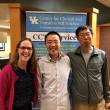This award is for investigators at all stages of career development and is intended to stimulate innovation for pilot studies that will lead to extramural funding.
A maximum of $50,000 will be awarded for a period of 12 months.
2022 Awardees
Mauro Pedrine Santamaria, DDS, MS, PhD
Associate Professor, Department of Research and Graduate Studies/Department of Oral Health Practice, College of Dentistry

Luciana Shaddox, DDS, MS, PhD
Professor, Department of Research & Graduate Studies/Department of Oral Health Practice, College of Dentistry

Octavio Gonzalez, DDS, MS, PhD
Associate Professor, Department of Research & Graduate Studies/Oral Health Practice, College of Dentistry
Understanding mechanisms of oral mucosa wound healing: A step toward precision therapy for vulnerable populations

Thomas Adams, PhD
Assistant Professor, Department of Psychology, College of Arts and Sciences
Is Fear Extinction Learning Relevant to the Etiology and Treatment of OCD?

2021 Awardees
Qingjun Wang, PhD
Assistant Professor, Department of Ophthalmology and Visual Sciences, College of Medicine
Developing a novel therapy for CLN3 disease-related neurological deficits

Chi Wang, PhD
Associate Professor, Department of Cancer Biostatistics, College of Medicine and Markey Cancer Center

Chunming Liu, PhD
Professor, Department of Molecular and Cellular Biochemistry, College of Medicine and Markey Cancer Center
A Novel Genomic Approach for High-Throughput Drug Screening

2020 Awardees
Ahmed Abdel-Latif, MD, PhD
Professor, Department of Cardiology, College of Medicine

Ashley Seifert, PhD
Associate Professor, Department of Biology, College of Arts and Sciences

Jonathan Satin, PhD
Professor, Department of Physiology, College of Medicine
Cell autonomous mechanisms underlying cardiomyocyte proliferation in adult spiny mice

B. Mark Evers, MD
Professor, Department of Surgery/Markey Cancer Center, College of Medicine

Susan Smyth, MD, PhD
Professor, Department of Internal Medicine & Divisions - Cardiology, College of Medicine
A Critical Contributory Role for Neurotensin in Atherosclerotic Cardiovascular Disease

Emilia Galperin, PhD
Associate Professor, Department of Molecular and Cellular Biochemistry, College of Medicine
Development of Therapeutic Strategies to Target Erk1/2 Signals in Noonan-Like Syndrome with Loose Anagen Hair

Peter Morris, MD
Professor, Department of Internal Medicine, College of Medicine

Christopher Waters, PhD
Professor, Department of Physiology, College of Medicine
The ARISE Study: Assessing the Role of Inclined Positioning in Acute Respiratory Distress Syndrome Patients’ Recovery

2019 Awardees
Kenneth Campbell, PhD
Professor, Department of Physiology and Cardiovascular Medicine, College of Medicine
Thick filament based therapies for heart failure

2018 Awardees
Matthew Hoch, PhD, ATC
Assistant Professor, Department of Rehabilitation Sciences, College of Health Sciences
Interaction between Mild Traumatic Brain Injury and Musculoskeletal Injury in Collegiate Athletes

Zain Guduru, MD
Assistant Professor, Department of Neurology, College of Medicine
A pilot study to examine apomorphine-induced BOLD activation in patients with Parkinson's disease

Meera Gupta, MD, MSCE
Assistant Professor, Department of Surgery, College of Medicine

Javier Neyra, MD, MSCS, FASN
Assistant Professor, Department of Medicine, Nephrology Division, College of Medicine
Alterations of Bone and Mineral Metabolism after Living Kidney Donation and Kidney Transplantation

Susan Smyth, MD, PhD
Professor, Department of Internal Medicine, College of Medicine

Nancy Webb, PhD
Associate Professor, Department of Pharmacology and Nutritional Sciences, College of Medicine
Serum Amyloid A (SAA) as a novel inflammatory mediator of thrombosis

Chi Wang, PhD
Associate Professor, Department of Biostatistics, College of Public Health

Susanne Arnold, MD
Professor, Department of Internal Medicine, College of Medicine
Chunming Liu, PhD
Professor, Department of Molecular and Cellular Biochemistry, College of Medicine
A Probabilistic Model to Identify Unique Tumorigenesis Process of Lung Cancer in Appalachian Kentucky
2017 Awardees
Subbarao Bondada, PhD
Professor, Department of Microbiology, Immunology & Molecular Genetics, College of Medicine

Markos Leggas, PhD
Associate Professor, College of Pharmacy
Enhancement of anti-tumor responses by blocking inhibitor effect of chronic lymphocytic leukemia derived interleukin-10
Chronic lymphocytic leukemia (CLL) is a lymphoproliferative disorder of B cells that accumulate in the peripheral blood. This lymphocytosis leads to serious complications such as lymphadenopathy, splenomegaly, anemia, and broad immunosuppression that results in increased infections and secondary cancers. CLL is the most prevalent adult leukemia in the western world, with the number of cases predicted to substantially increase in the next two decades. Immunotherapies are exciting new therapies that unleash the powers of the body’s immune system to attack the cancers. We discovered that some cancers such as CLL and some B-cell lymphomas produce a cytokine, interleukin-10, that suppresses the body’s anti-tumor immune response and thus interfering with immune based therapies. This proposal will investigate small molecule analogues of mithramycin that suppress IL-10 production without affecting the T-cells that are key to the anti-tumor response of the cancer patient. This proposal will also evaluate if these novel small molecules will work in synergy with the recently approved checkpoint inhibitors that are known to enhance patient’s anti-cancer immune response.

Adam Bachstetter
Assistant Professor, Department of Neuroscience, College of Medicine

John Gensel, MD
Assistant Professor, Department of Physiology, College of Medicine
An immunomodulatory therapy for mild traumatic brain injury

Amanda Fallin-Bennett, PhD, RN
Assistant Professor, College of Nursing

Ellen Hahn, PhD
Professor, College of Nursing
Smoke-free Policies in Long-Term Care Facilities
The smoking rate for older adults 65+ years in Kentucky is 12.3% compared to 9% in the U.S. Although the older adult smoking rate is relatively low compared to other sub-groups, long-term care (LTC) facilities in many states allow smoking indoors. As a result, SHS negatively impacts many older adults living in LTC facilities as well as those who work in and visit those locations. This is concerning because older adults suffer disproportionately from chronic health conditions caused or worsened by SHS. As of October 2, 2017, only 10 U.S. states/territories and 340 municipalities had enacted laws requiring 100% smoke-free indoor areas of skilled nursing facilities including common areas and private rooms. There is little reliable or valid data nationally on smoke-free policies in LTC facilities. Although Americans for Nonsmokers’ Rights (ANR) tracks these policies in ‘nursing homes (i.e., skilled nursing facilities),’ their data collection protocol is not systematic, and they compile data on smoke-free policies only in institutional facilities, but not in transitional or community-based settings. Without in-depth analysis of smoke-free policy in all types of LTC facilities, older adults, workers, and visitors will suffer disproportionately from exposure to SHS.
The Specific Aims are to: (a) compare differences in type and strength of smoke-free policies; and perceived impacts of the policies on health and fire safety in institutional, transitional, and community-based LTC facilities in Kentucky; (b) examine the association between strength of smoke-free workplace policies (by ordinance) and voluntary policies in LTC facilities in Kentucky; and (c) explore the perceived facilitators and barriers related to smoke-free policies in Kentucky’s Bluegrass Region. A secondary aim is to describe policy adherence, views toward the policy, healthcare outcomes, and other impacts in institutional LTC facilities that are mandated to be smoke-free by local ordinance in Kentucky.

2015 Awardees
Brian Delisle, PhD
Associate Professor, Department of Surgery, College of Medicine
Molecular Mechanism for Discordant Phenotypes in Brugada Syndrome

2014 Awardees
Joseph Abisambra, PhD
Assistant Professor, Department of Physiology, College of Medicine
Manganese-Enhanced MRI Detection of Neuronal Dysfunction in Pre-Symptomatic Tauopathy
Tauopathies, the most common of which is Alzheimer’s disease (AD), constitute the most crippling neurodegenerative threat to the aging population. Tauopathic patients have significant cognitive decline accompanied by irreversible and severe brain atrophy, and it is thought that neuronal dysfunction occurs years before diagnosis. Our current understanding of tauopathies has yielded promising therapeutic interventions, but they have all failed in clinical trials. This is partly due to the inability to identify and intervene in an effective therapeutic window early in the disease process. A major challenge that contributes to clarification of an early therapeutic window is limited technologies. To address these challenges, we will apply a sophisticated and innovative imaging approach, manganese-enhanced magnetic resonance imaging (MEMRI) coupled with parametric T1-mapping, which will determine pre-pathological and pre-clinical neuronal dysfunction in tau transgenic mice. MEMRI uses manganese as a contrast agent to reveal calcium dynamics in the parenchyma. Calcium dysregulation is a key feature associated with neuronal and death in AD and other tauopathies. Therefore, we will use MEMRI to reveal calcium dysregulation in tau transgenic mice in a longitudinal time course.

Justin Fraser, MD
Assistant Professor, Department of Neurosurgery, College of Medicine
Stroke and Traumatic Acute Brain Injury Line Indicator System for Emergent Recognition (STABILISER) Phase I Feasibility Study
In the search for a novel marker of stroke that could be rapidly assessed in blood, we developed a point-of-care (POC) lateral flow device (LFD) that detects levels of a neuron specific calcium sensor protein that is rapidly released into blood following neuronal injury associated with stroke and traumatic brain injury. We developed this to provide a point-of-care diagnostic tool to determine the presence of stroke or traumatic brain injury. Such a device would also be easy to use and interpret by physicians, emergency responders, and even lay-persons. Our preliminary data have demonstrated high association between detection of the biomarker in blood with severity of acute brain injury. We aim to evaluate this diagnostic tool in a first-in-humans feasibility study for patients with acute stroke and traumatic brain injury (TBI). We will evaluate inter-rater reliability of the device, as well as sensitivity and specificity to detect stroke and TBI.

2013 Awardees
Jayakrishna Ambati, MD, PhD
Professor, Ophthalmology & Visual Sciences, College of Pharmacy
A circulating biomarker of age-related macular degeneration
Age-related macular degeneration (AMD) is the major cause of irreversible blindness among the elderly in industrialized countries. This project proposes to study a circulating RNA as a biomarker for AMD. The project is conducted in two phases: a first phase, where healthy controls and patients with varying AMD status are enrolled in the study, and a second phase where the biomarker is characterized and quantified in the plasma samples of enrolled subjects. This study could identify an easily accessible circulating marker for AMD, which may permit early recognition of individuals at risk for AMD, as well as to stratify patients with established AMD according to their risk of progression.

Leigh Ann Callahan, MD
Professor, Department of Internal Medicine/Pulmonary, Critical Care and Sleep Medicine, College of Medicine
Mechanisms and Treatment of Skeletal Muscle Weakness in Acute Lung Injury
Skeletal muscle weakness acquired during admission to the intensive care unit (ICU) is now recognized as a major sequela of critical illness and a significant determinant of both acute and long term clinical outcomes. This severe debilitating muscle weakness affects the diaphragm, the major muscle of respiration, as well as the limb muscles. We showed that diaphragm strength is profoundly reduced (20% of normal) in ICU patients here at the University of Kentucky and that diaphragm weakness increased ICU mortality, prolonged duration of mechanical ventilation, and resulted in more transfers to chronic ventilator facilities because of failure to be liberated from mechanical ventilation. The peripheral muscle weakness acquired during critical illness is equally devastating with loss of functional capacity, long-term disability, and persists for up to 5 years after ICU discharge. The major problem is that there are currently are no treatments for ICU acquired muscle weakness. The purpose of this project is to determine the basic cellular pathways responsible for the evolution of skeletal muscle injury in an animal model of critical illness (acute lung injury), and to discover if pathway specific inhibition will preserve muscle function. We anticipate that findings from our studies will lead to potential new therapies for this devastating problem.

Moriel Vandsburger, PhD
Assistant Professor, Department of Physiology, College of Medicine
Contrast agent free MRI of fibrosis in the hearts of chronic kidney disease patients
Individuals who suffer from diabetes and chronic kidney disease suffer extremely high rates of mortality from heart failure. A key component underlying the progression of heart failure in these patients is the development of fibrotic tissue within the heart. Existing diagnostic techniques can not be used on these patients, leaving them without proper treatment. We are testing a novel magnetic resonance imaging method by which to identify fibrosis in the hearts of chronic kidney disease patients in an effort to enable earlier intervention and thereby reduce mortality.
